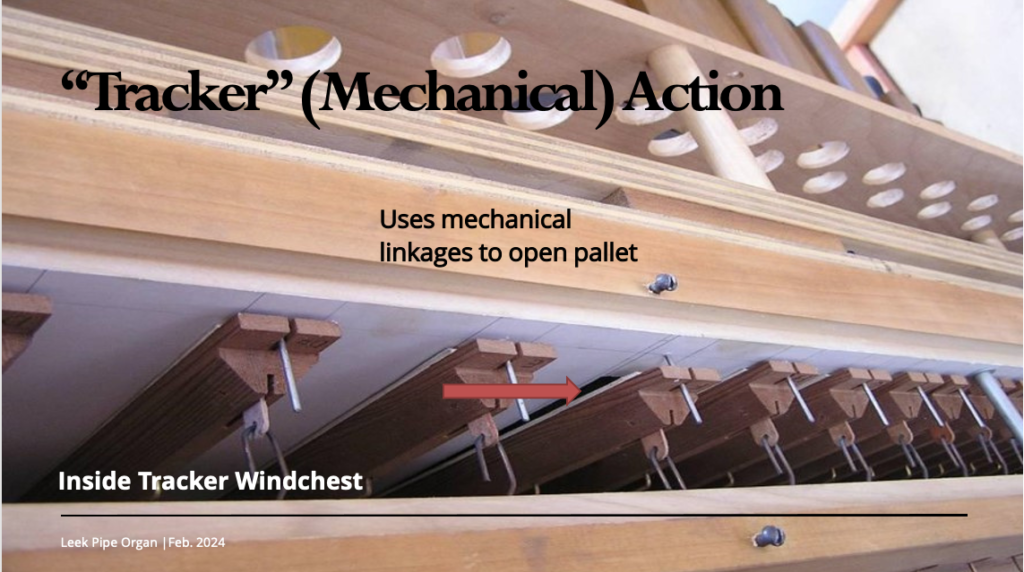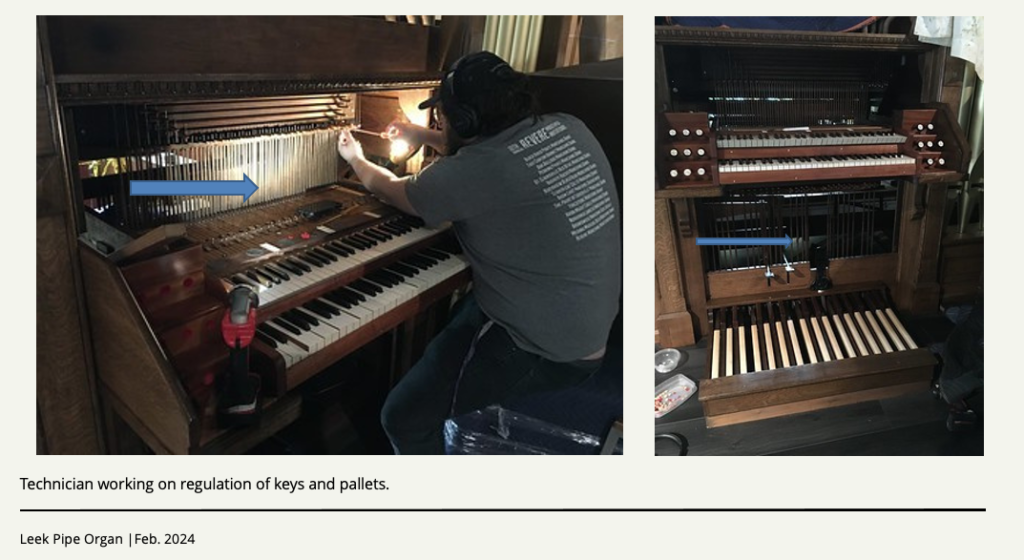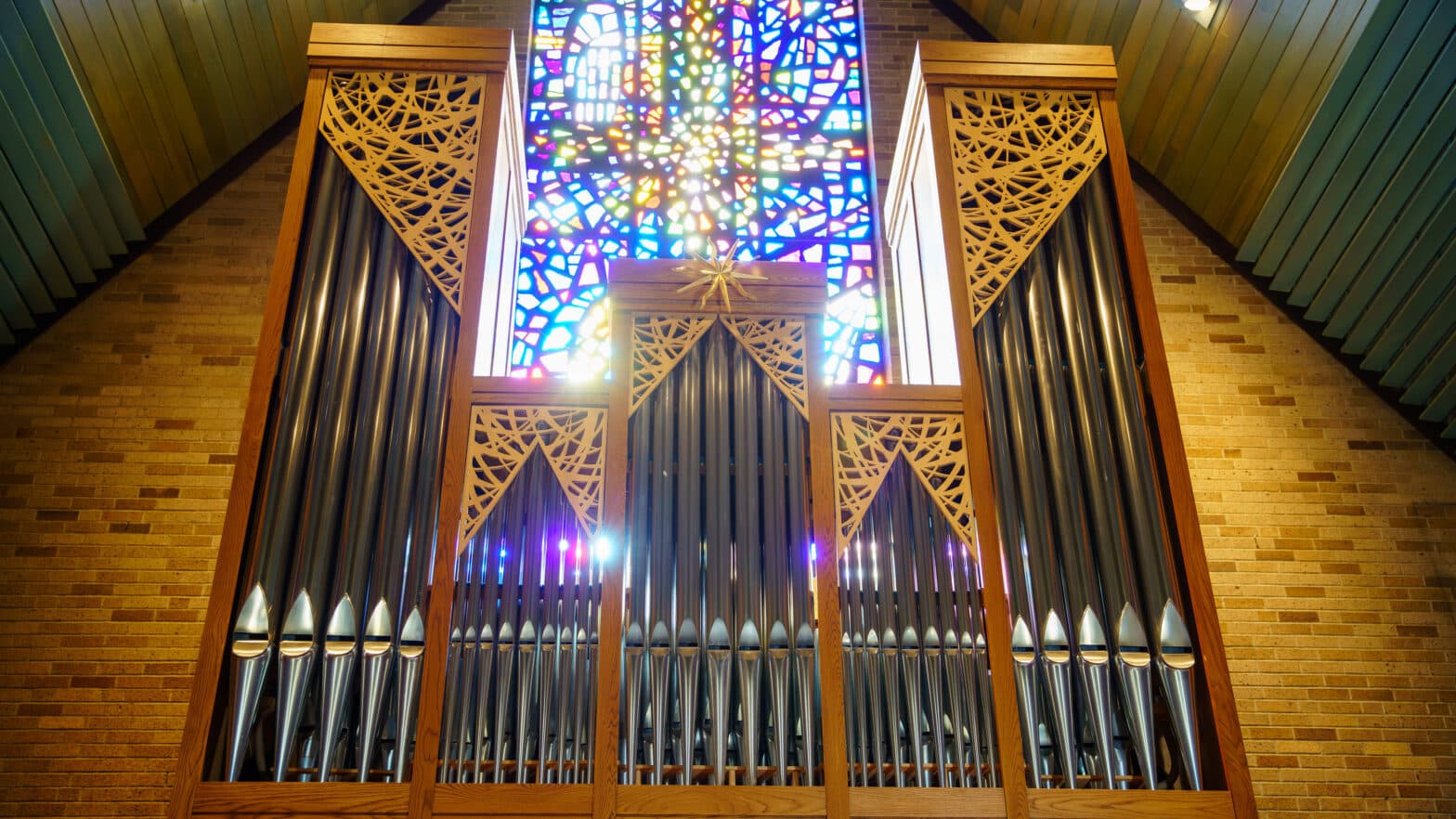“The most complex of all musical instruments, tracker pipe organs work mechanically rather than electronically. When the organist depresses keys, a complex set of wood and metal arms and levers is activated, opening valves that allow air to rush through the pipes — much like human breath makes a whistle operate — and with similar variations in tone. In the words of organist William Elliott, with this instrument the way you press the key influences how that pipe speaks. It is as one organist said … like having the wind at your fingertips.”*
What makes a Tracker Pipe Organ unique?
Tracker pipe organs stand out due to their mechanically driven action. Unlike electronically operated organs, pressing the keys directly activates a complex network of wood and metal levers and arms. These open valves, allowing pressurized air to surge through the pipes, similar to how breath activates a whistle. This direct mechanical connection, grants the organist greater control over how the pipes respond, influencing the final sound.
Notable Tracker organs in the video below demonstrate their distinctive ageless sound.
Tracker Actions : Control vs Convenience
Organists and organ builders hold differing viewpoints on tracker action. Some organists value the tactile feedback and the increased control they have over the sound. This allows for nuanced playing and a more direct connection with the instrument. However, others favor the convenience and simplicity offered by digital organs.
For tracker organs to be truly fulfilling to play, regular maintenance is crucial. This involves checking springs, trackers, and regulation to ensure the system functions optimally, providing a smooth and responsive playing experience.
The Pluck Point: A Defining Feature
A key element of tracker organs is the pluck point. This unique mechanism sets them apart from other organ types. It acts as a fulcrum within the mechanical linkage (tracker), storing and releasing energy to generate sound. “The Organ: An Encyclopedia” by Routledge *** dives deeper into the fundamentals of tracker action, highlighting the trackers’ capacity to manage this energy flow effectively.
While for some the “pluck” may be impercetible it is when the pallet is first separated from the chest and the initial flow of air is directed to the pipe. This initiation of the sound is similar in many ways to the action of plucking a guitar string, or even more similarly, a harpsichord string. Some musicians say that playing a tracker action organ (without couplers) is similar in feel to playing a harpsichord. While the harpsichord is a plectra plucking the string, in a tracker organ the pluck is the resistance of the wind pressure holding the pallet shut.
How is the classic Tracker sound created?
In the Tracker organ, there is no string under tension providing the resistance to the pluck. There is, instead, a reservoir of pressurized air. More specifically, there is pressurized air stored in the chest, bellows, and air at ambient atmospheric pressure in the pipes and leading all the way back through the tone channels to the pallets.
In their resting position, the pallets are closed and these two areas of different pressure do not interact with each other. When a pallet is actuated, it will begin to open. In order to do this, it must have enough force to overcome the imbalance of these two pressures. This is the same phenomenon as a suction cup or a tightly sealed lid on a jar. Once one side of the seal can be breached, then the rest of the suction cup releases easily as the air pressures on either side have balanced. This point where the pallet first overcomes the suction cup force is referred to as “pluck point”.
The properly sized channel and pallets in the chest are controlled by trackers and rollers, backfalls and various class levers to allow the key movement the most precise motion for the performer. The tracker action becomes a partnership between the musician’s hand and the keyboard.
Watch the video below to learn how an organ is built.The Tracker Wind System!!!
According to Master Organ Builder “Francois Bedos De Celles” , when building tracker organs the builder must apply the fundamentals of mechanics and statics. He/She must use the appropriate types of lever and fulcrums within the tracker design. The use of First, Second and Third class levers gives the key and the pallet action the greatest advantage.
“The wind chamber with its pallets, grooves, and sliders – this whole appliance- is called the wind chest and the universally accepted type of construction, the slider chest.” “The grooves are located above the pallets.


In making groove partitions, the flat chest, above the wind chamber (the location where the pallets are situated with a spring), is divided into just as many spaces or channels as there are keys.” “When a pallet is opened, the compressed air from the wind chamber flows into the groove, and thereafter, through the borings in the top board and into the pipes – provided that the slider does not prevent it.” **
Another element that contributes to pipe speech quality on a slider chest is the air expansion chambers under pipe feet that cushion the onset of air pressure to the pipe allowing the pipes to be voiced on the quickside.
While some aspects of Tracker organ construction methods are timeless others continue to evolve as detailed in Part 2. Bookmark this page on your browser and return to read more soon.
Many organists share that the experience of playing a tracker organ is very enjoyable as they feel better connected to the control aspects of the instrument than they might with an electric action organ (direct electric, pneumatic).
The intimacy between the player and the tracker serves as a creative source of inspiring worship accompaniment.
Thank you for reading – Stay Tuned for Part 2
Sources/Credits:
* Tracker organ Speaks in 18th Century Voice by Linda Warren, UPI Archives
**”Organ building and design” by Poul-Gerhard Andersen
***”The Organ: An Encyclopedia” entry titled “pluck point”
http://organforum.com/forums/81986/S…ead.aspx#81986 http://www.sydneyoperahouse.com/uplo…GrandOrgan.pdf
http://www.nzorgan.com/
Expansion chambers under the pipe feet, Lawrence Phelps.



